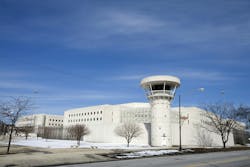Prison security looks skyward with advanced drone detection network
Prisons and correctional facilities are fighting an invisible enemy from above: sophisticated drones delivering contraband to inmates with unprecedented precision and frequency. This aerial invasion has become one of the most pressing security challenges facing correctional facilities today.
The numbers are stark. According to a U.S. Department of Justice report, illegal drone drops at correctional facilities are increasing by 50% or more annually, with no signs of slowing. These aerial invaders carry everything from drugs and cell phones to weapons, creating what security experts call an unprecedented threat to facility safety.
Andy Schreyer, Chief Security Marketing Officer at Stone Security, a Rocky Mountain-based enterprise security integration firm. Stone Security has been researching and studying drone use for security and protection against the illegal use of drones for their customers for more than 5 years.
“This specific behavior and illicit use of drones is only something we have been hearing about fairly recently,” explained Schreyer. “It’s concerning because smugglers can operate drones remotely, evading traditional ground-based security measures. Drone-delivered contraband has become a significant threat, largely due to the accessibility and anonymity that drone technology provides.”
A recent article on the website Corrections1 discusses a drug trafficking operation in Sanford, Florida, where the suspects were distributing various drugs, including fentanyl, heroin, meth, and “Molly,” as well as an assortment of weapons such as machine guns, rifles, and handguns. In addition to the dangers of contraband, the threat is more sophisticated than many realize.
"Today's drones can easily carry several pounds of payload," said Schreyer. "But beyond contraband delivery, drone cameras are also being used to survey security protocols and collect guard details. A drone’s surveillance capability creates a complex security challenge that requires equally sophisticated countermeasures."
A Comprehensive Defense
The first step for a comprehensive defense is to conduct a vulnerability assessment, which provides the foundation for any drone mitigation strategy. These assessments evaluate geographic layout, perimeter security, environmental factors like lighting and sightlines, and blind spots that may attract drone operators. Crucially, they also identify high-risk times—like shift changes and low-visibility weather—allowing managers to focus resources when and where they are most needed.
Staff training and response protocols form another crucial layer of defense. Training staff to detect drones and establishing clear response protocols are critical to combat drone threats effectively. Personnel must be trained to recognize drone indicators, including distinct sounds and visual markers.
"Response time is critical," said Schreyer. "Prison staff need to know exactly how to secure specific areas, notify authorities, and block access to potential drop zones the moment a drone is detected; and this has to happen very quickly."
Clear procedures for notifying authorities, collecting evidence, and responding to drone sightings need to be in place. Effective response protocols may include securing specific facility areas, notifying local law enforcement or drone mitigation specialists, and immediately blocking inmate access to any suspected contraband drop zones.
The Detection Arsenal
Modern drone detection systems employ multiple technologies working in concert, creating a multi-layered defense against aerial intrusion. The sophistication of these systems continues to evolve, matching the pace of advancing drone capabilities.
Detection systems are most effective when layered and integrated into a single monitoring platform. A centralized system that combines RF scanning, radar, acoustic sensors, and optical imaging allows facility staff to receive real-time, cross-verified data about incoming drones. This multi-modal approach minimizes false positives, maximizes detection accuracy, and provides facility managers with a detailed situational awareness map, empowering them to take immediate action to prevent contraband delivery.
"The integration of multiple detection technologies creates a comprehensive defense network," explained Schreyer. "When these systems work together, they provide unprecedented awareness of the airspace and greatly enhance the facility’s ability to prevent contraband deliveries."
- Radio Frequency (RF) Scanners: RF scanners monitor the electromagnetic spectrum for signals emitted by the drone's controller or GPS system. These scanners are versatile, working both day and night and in various weather conditions, making them invaluable for continuous surveillance. They also allow for early detection, as they can pick up signals from significant distances and provide valuable data on the drone's location and direction.
- Radar Systems: Originally designed for military applications, radar has been adapted for detecting small, fast-moving objects like drones. Radar is especially useful for long-distance detection and in low-visibility conditions, making it a reliable option for large facilities.
- Acoustic Sensors: Acoustic sensors detect the distinct sounds generated by drone propellers and motors. While they're best suited for short-range detection, they can add an additional layer of security when placed strategically around the perimeter. Acoustic sensors are especially useful for detecting low-altitude drones attempting covert approaches and, when combined with smart audio technologies, can differentiate drone sounds from environmental noise.
- Optical and Thermal Imaging: High-definition cameras, including PTZ cameras with active tracking capabilities, can provide visual confirmation of a drone presence. Thermal imaging is also particularly valuable for nighttime detection, as drones emit heat that can be tracked visually. Imaging technology is often used alongside other sensors to confirm and visually track the drone's location, enabling a comprehensive view of airspace threats.
Physical Infrastructure Enhancements
While detection systems are critical, physical infrastructure enhancements provide an additional layer of defense. Some facilities install netting or barriers over open areas, making it more difficult for drones to drop contraband directly into secure areas. Enhanced lighting can further deter drone operators by increasing the visibility of drones and making it easier for detection systems and personnel to spot them.
Modern drone detection systems employ multiple technologies working in concert, creating a multi-layered defense against aerial intrusion.
Perimeter adjustments, like extending fence heights and using anti-drone coatings, can also disrupt potential drone deliveries. These physical measures, when combined with detection systems, create a layered security approach that increases the likelihood of intercepting drones and deterring future attempts.
The Legal Battleground
The Federal Aviation Administration (FAA) has strict rules governing drone use in restricted airspaces, including around corrections facilities. Enforcement of these airspace restrictions is possible through collaboration with the FAA. Facilities can seek to establish these areas as "no-fly zones" through formal applications to the FAA, providing legal grounds for drone interdiction and potential prosecution if a pilot violates these regulations.
Successful prosecution requires collaboration between facilities, local law enforcement, the FBI, and the Department of Homeland Security. Law enforcement agencies can assist in tracking drone signals and gathering intelligence on drone operators, including locating pilots in the vicinity of corrections facilities. Setting up real-time communication channels with these agencies allows facilities to respond swiftly when a drone is detected.
Prosecuting drone operators requires strong evidence linking them to contraband deliveries, so facilities should maintain high-quality detection and tracking records. Radar and RF systems can log drone paths and signals, and imaging systems can capture visual evidence, all of which can be used in court. Clear documentation and adherence to legal protocols during drone incidents increase the chances of successful prosecution.
Public Awareness and Deterrence
A robust prosecution strategy is more effective when coupled with public awareness initiatives. By working with local law enforcement and the media, facilities can publicize successful interdictions and convictions, sending a clear message that drone-based contraband delivery is a high-stakes crime.
Facility managers can work with local businesses that sell drones to help educate the public about restricted airspace laws and the legal risks associated with unauthorized drone use near corrections facilities. Educating recreational drone users about restrictions around prisons can reduce accidental incursions and reinforce the perception of facilities as protected zones.
The public awareness campaign should inform the public—and especially any individuals with criminal ties—of the penalties associated with drone-related contraband delivery. This can help reduce attempts and increase community vigilance.
Looking Ahead
The drone threat continues to evolve, with smugglers adopting increasingly sophisticated tactics. Autonomous flight capabilities, low-visibility operations, and strategic timing of deliveries during shift changes or poor weather all present ongoing challenges for corrections facilities.
"Success requires staying ahead of the technology curve," said Schreyer. "Facilities must implement comprehensive strategies combining detection systems, physical security measures, and strong partnerships with law enforcement. This multi-layered approach, combining technology and legal accountability, offers corrections facilities the best path forward in safeguarding against drone threats."
About the Author

Howard Carder
freelance writer specializing in the physical security and professional audio/video industries
Howard Carder is a seasoned freelance writer specializing in the physical security and professional audio/video industries. With over 30 years of experience, including a long tenure at a large, global video security company, Howard has crafted compelling content for leading brands and publications across the industry. His expertise spans video security and Pro AV technologies, allowing him to distill complex topics into engaging narratives. Howard's work includes hundreds of case studies, white papers, and thought leadership articles. When not writing, he enjoys playing music and exploring healthy cooking. Learn more at www.hcwriter.com.
